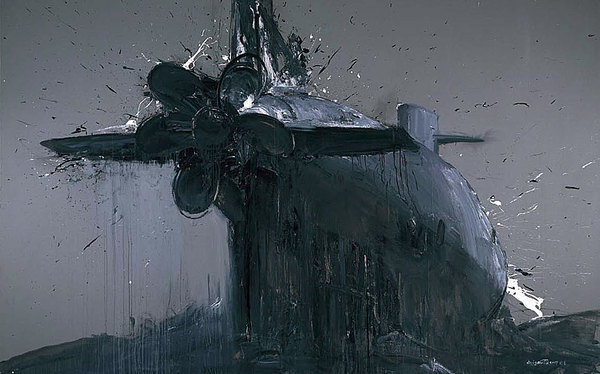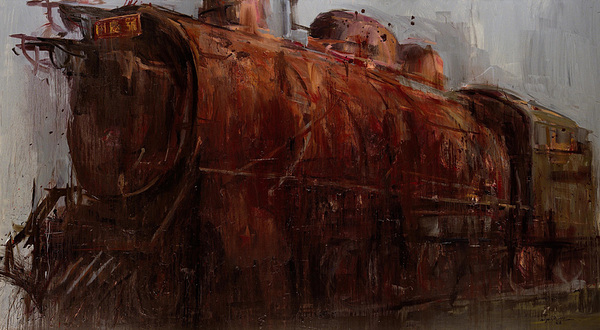This is an archive of the ArtCat Zine, 2007-2009. Please visit our new project, IDIOM.
Cui Guotai's Evidence of a Lost Era
Evidence of a Lost Era
Cui Guotai
Chinasquare New York - 545 W. 25th St, 8th Fl, New York NY
1 October - 1 November 2008
Much ink has been spilled recently over the question of the economic crisis. There are some who want it to be a watershed, a sign that civilization can really break itself out of its contemporary dead end. We had heard over the past few decades that capitalist society had become post-industrial, a "postmodern condition" fueled by ever more abstract flows of global finance capital; today, it seems increasingly clear that what had looked like a qualitatively new form of socioeconomic existence is in fact bedeviled by the very same contradictions as the old. Appropriately, the crisis on Wall Street has not yielded any novel ideological solutions. On both sides of the ideological divide, sincerity has been replaced by desperation: the Right no longer believes in a pure market, only in the spoils of controlling the state apparatus, while the Left is scared to death of putting forward a new idea instead of dressing up the dessicated corpses of Social Democracy (which has proved unable to escape being implicated in the financial catastrophe) and Che Guevara quixotism. The crisis suggests the possibility that we might be forced into some truly new configuration, simply by the ineluctable logic of market events.
To believe this is to dream the great dream of the twentieth century — that the economic process could hold the key to a transformation of human existence. It was the stuff of science-fiction fantasies, to be sure, and served as the unconscious collective aspiration of bourgeois Great Societies. But it was equally the substance of the socialist vision. Collectivization, the first Five Year Plans, the Great Leap Forward: these were not simply economic policies but the outlines of a productivist utopianism that could overcome rather than resolve the class struggle. Productivism was fundamentally an aesthetic vision — look, for instance, at Marinetti in 1909:
We will sing of ... the gluttonous railway stations devouring smoking serpents; factories suspended from the clouds by the thread of their smoke; bridges with the leap of gymnasts flung across the diabolic cutlery of sunny rivers: adventurous steamers sniffing the horizon; great-breasted locomotives, puffing on the rails like enormous steel horses with long tubes for bridle, and the gliding flight of aeroplanes whose propeller sounds like the flapping of a flag and the applause of enthusiastic crowds.
Cui Guotai's canvases, exhibited last month at ChinaSquare NYC, are particularly timely in this context — for Guotai makes his intervention precisely on the level of the economic imaginary. What is remarkable about his work is that it does not articulate a counterargument. He does not challenge industrialism by making reference to a reified, Rousseauist nature (except as a thin green ring around the baleful truck in Into Tibet); he appeals neither to humanity nor to humaneness; he does not even point to an apocalyptic or a utopian futurity. In fact, he scrupulously follows Marinetti's instructions: airplanes and locomotives, bridges and factories, form the subject matter of his work. His is an almost realist expressionism.
What is the aesthetic significance National Celebration, a triptych depicting a gigantic rust-colored locomotive? Nothing about the painting explicitly suggests that a judgment is being meted out — were the outline a little sharper, the colors a little brighter, it could be called Socialist Realism. Yet, of course, we cannot but read the title as ironic. Heidegger wrote that though the objects in a museum remain for us to look at, they are no longer what they were: their world is gone. It is in this sense that Guotai's cars and trains are the evidence of a lost era: by appearing to us in all their drabness and lostness, they show us what we can no longer think.
Guotai's cityscapes — Our May 12th and Beijing Bridge — are near mirror-images of one another. Beijing Bridge is a landmark of the infrastructural self-overcoming of a newly muscular China; May 12th is the date of the horrifying 2008 earthquake in Sichuan. In each painting, what looks initially like the outline of a concrete built environment collapses into wild expressionist abstraction, though without implicating any sort of accompanying liberation. There is a contradiction here, but there is no resolution. In On Contradiction, Mao defined “the emergence of a new process” as follows: “The old unity with its constituent opposites yields to a new unity with its constituent opposites, whereupon a new process emerges to replace the old. The old process ends and the new one begins. The new process contains new contradictions and begins its own history of the development of contradictions.” But the constituent opposites of Beijing Bridge do not yield to any new unity. The dialectic of creation (Beijing Bridge) and destruction (May 12th) never forms a synthesis, and neither does that of realism and expressionism. The “Lost Era,” here, is a time when some teleology could have organized these disjunctions into a semblance of meaning; today, they are as senseless as the locomotive.
Some still appear to believe that the economic crisis will be the rupture that exposes the contradictions of capitalism and allows us, thereby, to transcend them. Guotai shows the fatal flaw in this hypothesis: it still imagines the economic (either in its growth or its collapse) as filled with a productive potentiality, an ability to overcome contradiction. A look at any of his paintings drives the point deeper still: the more dead and monotonous they appear, the farther we are from their world.
ZINE
HOME
TIPS / COMMENTS
CATEGORIES
CONTRIBUTORS
- Greg Afinogenov
- B. Blagojevic
- Adda Birnir
- Susannah Edelbaum
- Julie Fishkin
- Paddy Johnson
- Jessica Loudis
- Christopher Reiger
- Andrew Robinson
- Peter J. Russo
- Blythe Sheldon
- S.C.Squibb
- Hrag Vartanian


